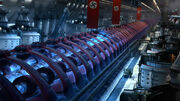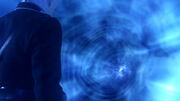No edit summary |
(Undo revision 1447632 by 109.58.207.31 (talk) vandalism) |
||
| (24 intermediate revisions by 14 users not shown) | |||
| Line 1: | Line 1: | ||
| + | {{at|xx}} |
||
| − | The '''temporal conduit''' is a device which allows travel through time. A group of [[Na'kuhl]] led by [[Vosk]], having escaped to [[1944]] [[Earth]], attempted to return to their own [[29th century]] by constructing a temporal conduit in [[New York City]]. However, they were forced to use local materials, which they secured through an alliance with [[Nazi]] [[Germany]]. The primitive technology used made the machine enormous, and the Na'kuhl had difficulty keeping the conduit stable for more than a few seconds. The conduit was destroyed moments before the Na'kuhl could enter it by the [[Enterprise (NX-01)|''Enterprise'']]. ([[ENT]]: "[[Storm Front, Part II]]") |
||
| + | [[File:Temporal conduit machinery.jpg|thumb|The machinery of the temporal conduit.]] |
||
| + | [[File:Temporal conduit.jpg|thumb|[[Vosk]] prepares to enter the conduit.]] |
||
| + | The '''temporal conduit''' was a device created by the [[Na'kuhl]] for the purpose of [[time travel|traveling through time]]. |
||
| + | |||
| + | A group of Na'kuhl from the [[29th century]] led by [[Vosk]] escaped near-defeat in the [[Temporal Cold War]], using a one-way form of [[stealth]] time travel, to reach [[Earth]] in [[1944]], in an [[alternate timeline]] created by multiple [[temporal incursion]]s by various factions in the Cold War. There, the Na'kuhl constructed a temporal conduit in [[New York City]] in an attempt to return to the future. However, they were forced to use local materials that they secured through an alliance with [[Nazi]] [[Germany|Germans]]. The primitive [[technology]] used made the machine enormous, and the Na'kuhl had difficulty keeping the conduit stable for more than a few seconds. After several failed attempts to operate the temporal conduit, the Na'kuhl were eventually successful, and traveled to the [[31st century]], where they defeated [[Daniels (Crewman)|Daniels]]'s faction and ignited the Cold War into an all-out conflict, resulting in the very alternate timeline to which they had originally escaped. In an effort to stop the Na'kuhl, Daniels sent [[Captain]] [[Jonathan Archer|Archer]] and the {{EnterpriseNX}} to 1944, where they were able to destroy the conduit before Vosk could enter it. This had the effect of resetting the timeline to its proper form, and bringing an end to the Temporal Cold War. ({{ENT|Storm Front|Storm Front, Part II}}) |
||
| + | |||
| + | [[de:Vosks Zeitkanal]] |
||
| + | [[Category:Time travel]] |
||
Revision as of 15:41, 29 October 2012
AT: "xx"

The machinery of the temporal conduit.

Vosk prepares to enter the conduit.
The temporal conduit was a device created by the Na'kuhl for the purpose of traveling through time.
A group of Na'kuhl from the 29th century led by Vosk escaped near-defeat in the Temporal Cold War, using a one-way form of stealth time travel, to reach Earth in 1944, in an alternate timeline created by multiple temporal incursions by various factions in the Cold War. There, the Na'kuhl constructed a temporal conduit in New York City in an attempt to return to the future. However, they were forced to use local materials that they secured through an alliance with Nazi Germans. The primitive technology used made the machine enormous, and the Na'kuhl had difficulty keeping the conduit stable for more than a few seconds. After several failed attempts to operate the temporal conduit, the Na'kuhl were eventually successful, and traveled to the 31st century, where they defeated Daniels's faction and ignited the Cold War into an all-out conflict, resulting in the very alternate timeline to which they had originally escaped. In an effort to stop the Na'kuhl, Daniels sent Captain Archer and the Enterprise NX-01 to 1944, where they were able to destroy the conduit before Vosk could enter it. This had the effect of resetting the timeline to its proper form, and bringing an end to the Temporal Cold War. (ENT: "Storm Front", "Storm Front, Part II")
